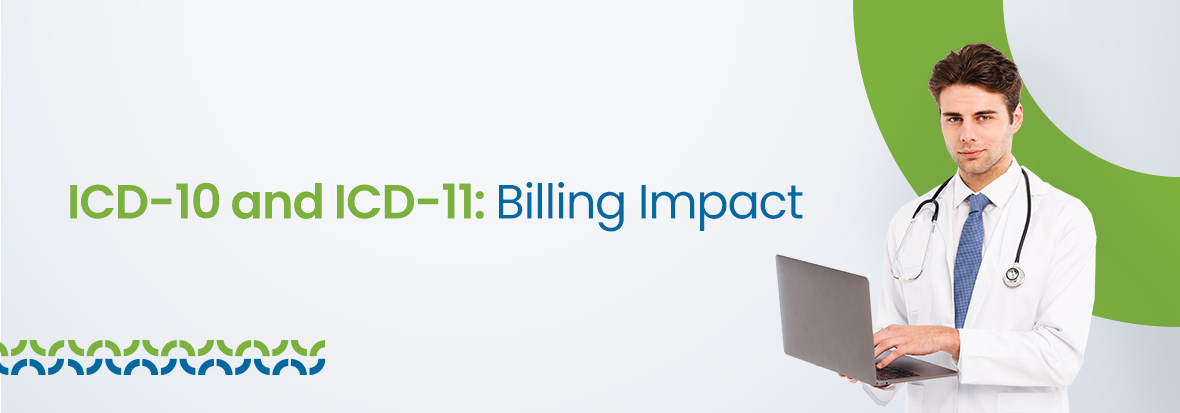Healthcare is about to face its biggest coding change in decades. According to NIH/NLM research, only 23.5% of 943 common ICD‑10‑CM codes had an exact stem match in ICD‑11. This significant difference indicates that billing departments need new workflows, while technology vendors must rebuild software infrastructure.
The transition introduces clustered coding structures, digital-first architecture, and expanded diagnostic capabilities that require extensive staff training and system modifications. Organizations that use this time for preparation will effectively gain competitive advantages, while those who don’t will face significant operational and financial risks.
What Is the Current Situation of ICD-10 Codes?
Healthcare organizations currently face significant challenges with ICD-10’s aging framework. Today’s coding professionals report increasing difficulty capturing complex medical conditions accurately within the existing 14,000-code structure.
Current industry statistics reveal troubling trends. Claim denial rates hover between 5-10%, with coding inaccuracies contributing significantly to these rejections. The healthcare system now processes billions in claim resubmissions annually due to ICD-10 coding limitations.
Medical practices today struggle with:
- Rising “unspecified” category usage due to inadequate code options
- Increased coding time for complex cases requiring workarounds
- Growing frustration among clinical staff with outdated classifications
- Revenue losses from claims requiring manual reviews and appeals
Are ICD-10 Codes Outdated?
ICD‑10 will not immediately stop being used. Many countries, including the USA, currently rely on ICD‑10 for clinical documentation, billing, and reporting. ICD‑11 is meant to replace ICD‑10 gradually, but the transition is phased and country-specific. It’s not an overnight switch. Even with its limits, ICD-10 has created stable relationships with insurance companies. But the system’s age shows in revenue losses and poor documentation.
How is ICD-11 Different From ICD-10?
WHO built ICD-11 from scratch rather than just updating the old system. They are fixing major problems while adding features that work with today’s healthcare technology.
Complete Scale Change
ICD‑11 contains ≈17,000 unique codes in its MMS (Mortality and Morbidity Statistics) and over 120,000 codable terms. This vastly exceeds ICD‑10’s ~14,000 codes thanks to expanded terminology. The system reorganizes medical knowledge into 27 chapters and adds five completely new areas:
- Diseases of the immune system
- Sleep-wake disorders
- Conditions related to sexual health
- Traditional medicine conditions
- Enhanced mental health categories
- Over 5,500 rare diseases are now included
The coding format expands to 1A00.00 through ZZ9Z.ZZ, giving much more room for specific diagnoses. This growth reflects three decades of medical advances that ICD-10 couldn’t handle.
Paradigm Shifts in Medical Coding
ICD-11 introduces “clustered coding” with post-coordination. Instead of hunting for one perfect code, providers combine a main “stem” code with “extension” codes to build exact descriptions.
This digital-first system includes built-in API connections. It works directly with electronic health records and supports automated coding help. Unlike older versions, ICD-11 updates continuously online instead of waiting years for new editions.
Head-to-Head Comparison Between ICD-10 and ICD-11
The differences between ICD-10 and ICD-11 go far beyond just having more codes:
| Feature | ICD-10 | ICD-11 |
|---|---|---|
| Total Codes | ~14,000 | ~17,000 |
| Chapters | 22 | 27 |
| Format | A00.0 – Z99.9 | 1A00.00 – ZZ9Z.ZZ |
| Coding Method | Single code | Clustered with extensions |
| Updates | Periodic revisions | Continuous digital updates |
| Rare Diseases | Limited coverage | 5,500+ included |
Structural Differences in Practice
Healthcare providers must understand how ICD-10 and ICD-11 handle complex conditions differently. Take a patient with Type 2 diabetes and diabetic cataract. ICD-10 uses one code: E11.36. ICD-11 uses a stem code (5A11 for Type 2 diabetes) plus extension codes for complications, severity, and other details.
This clustered method allows exact precision while staying flexible. Healthcare providers can capture just the right amount of detail for their needs, whether for basic billing or detailed research.
New Medical Territory Expansion
ICD-11’s new chapters fill important gaps in medical classification. The immune system chapter provides specific codes for conditions scattered across multiple old sections. Sleep disorders get their own space, showing how sleep medicine has grown.
Including over 5,500 rare diseases helps specialized providers who struggled with poor coding options before. Mental health gets major restructuring, moving away from arbitrary limits toward more useful clinical approaches.
Investment Requirement for ICD-11 Transformation
Moving to ICD-11 requires big upfront spending but offers major long-term returns through better coding accuracy and less administrative work.
Small practices should plan for multiple thousands in transition costs, and large health systems face a hefty amount of expenses. These costs cover technology upgrades, staff training, workflow changes, and lost productivity during the learning period.
The timeline runs 4-5 years for complex healthcare systems. Organizations need sustained financial commitment and resource planning. Expect dual coding periods, extensive testing phases, and comprehensive staff education programs.
How ICD-11 Will Make a Difference in ROI?
Current claim denials cost the US healthcare system billions each year. Much of this comes from coding mistakes and a lack of detail. Research shows organizations with detailed coding systems see 30% fewer claim denials. That translates directly to better cash flow and lower administrative costs.
ICD-11’s enhanced detail enables more accurate billing. This could increase payment rates for complex cases that were undercoded before. The system works well with value-based care models, helping healthcare organizations show patient outcomes and quality measures.
Implementation Challenges To Watch Out for
Unlike past coding changes, ICD-11 needs fundamental changes to technology systems and clinical workflows. This creates challenges that go way beyond traditional training programs.
Technology Transformation
EHR systems must be updated to support both ICD-10 and ICD-11 during the transition period. Databases must expand for longer codes. Validation rules need a complete rebuild to support the new logic.
Most importantly, API integration with WHO services becomes essential for accessing the continuously updated system. This includes:
- Real-time code lookups
- Automated coding suggestions
- Seamless billing system integration
- Expanded database storage capacity
Training Requirements
Staff training programs must address the fundamental differences between ICD-10 and ICD-11. It’s expected that each staff member will need about 20-60 hours of training to become skilled with ICD-11’s new approach. This training goes beyond learning new codes to understanding completely different classifications and decision-making.
Real World Results of ICD-11
Early adopters provide valuable insights into ICD-11’s real-world performance and practical benefits.
Field Study Results Show Progress
In a WHO-supported web-based field study involving 928 clinicians from multiple WHO regions, the ICD-11 Clinical Descriptions and Diagnostic Guidelines (CDDG) achieved 71.9% diagnostic accuracy, compared to 53.2% with ICD-10. In addition, ICD-11 was rated as easier to use, clearer, better fitting, and faster for diagnosis using standardized clinical vignettes.
International Implementation Progress
35 countries actively used the ICD-11 system for clinical records and billing from 2022 to 2024. This implementation study gives solid evidence of the system’s effectiveness and practical benefits. Scotland led the way by implementing ICD-11 for mental health services in November 2022. They became the first country worldwide to adopt this specific part.
This strongly supports ICD-11’s clinical usefulness and gives confidence to US healthcare organizations preparing for the transition.
Are US Healthcare Organizations Prepared for ICD-11 Transition?
Despite the approaching timeline, significant gaps exist in how prepared the healthcare industry really is for the ICD-11 transition.
Current State of Healthcare Organizations
Most healthcare organizations are still in the early stages of planning. They’re focused on basic awareness instead of building solid preparation strategies. Training program development is lagging behind what experts recommend. Change management efforts often don’t have the scope needed to make this work.
The organizations that are getting ready have already put together dedicated implementation teams. They’ve started talking with vendors and begun educating their staff. These early adopters are setting themselves up for much smoother transitions and will likely gain competitive advantages.
Vendor Preparation Status
Major EHR providers are all over the map when it comes to ICD-11 readiness. Some vendors have opted for early support, while others are still developing their offerings. Healthcare organizations today need to stay connected with their vendors to understand timelines and ensure everything works together seamlessly.
Strategic Approach for Implementing ICD-11
Getting ICD-11 implementation right requires thorough planning, smart resource allocation, and careful execution across different parts of your organization.
Immediate Actions You Need to Take
Healthcare organizations need to get cross-functional implementation teams up and running immediately. Make sure you have members from coding, IT, clinical, and finance departments involved. The next step is to assess vendors immediately to determine your systems’ capabilities, identify areas that need upgrading, and establish timelines for necessary actions.
Budget planning needs to cover:
- Technology investments
- Training costs
- Productivity drops during the transition
- Staff communication programs to keep everyone informed
Implementation Strategy
Dual coding is the most effective way to go through this transformation. This allows organizations to remain fully operational while building up ICD-11 capabilities. Technology upgrades need careful planning to avoid disrupting operations.
As for your staff, start comprehensive training programs well before deadlines hit. Teams need adequate time to develop proficiency with these new coding approaches. Additionally, implement performance monitoring systems to track how things are going and progress over time.
Ending Note
The ICD-10 and ICD-11 transition represents the most significant coding evolution since ICD-9. With less than one in four codes matching between systems, healthcare organizations face major adjustments ahead.
Why This Matters:
- Implementation costs range from thousands to millions
- Billions in annual claim denials could drop by 30%
- Better coding accuracy means faster payments
- Enhanced patient care documentation becomes possible
Critical Next Steps:
- Form implementation teams now
- Assess vendor readiness immediately
- Begin staff training programs
- Plan technology upgrades carefully
The preparation window keeps shrinking. Healthcare organizations that start planning today will handle this massive transition much better than those who wait.

